Items
Search full-text
sunday school
-
 2022.90: The taming of Teresa A hard backed novel by Margaret C. Field. Bookplate in the inside front page states the book was presented to Doris Milner in 1929 as a prize for regular attendance at the Sunday School, Saltaire Congregational Church during 1929.
2022.90: The taming of Teresa A hard backed novel by Margaret C. Field. Bookplate in the inside front page states the book was presented to Doris Milner in 1929 as a prize for regular attendance at the Sunday School, Saltaire Congregational Church during 1929. -
D4-098: Attendance certificateFirst prize attendance certificate for Stanley Chew at Saltaire Congregational Church Sunday School 1926
-
D4-015: 'The Sentinal' No.2 (1917)Original copy of 'The Sentinal' No.2 (1917) [Sunday School newsletter ?]
-
D4-033: Leisure - ReligionOriginal photograph of a Sunday School 'May Queen' group of young girls
-
2018.49: The History of the Mill Hill School Foundation 1807-2007The History of the Mill Hill School Foundation 1807-2007 by Roderick Braithwaite. Titus Salt Junior attended this school for two years up to 1855. His brothers William Henry, George, Edward and Herbert also attended. The School was an independent school in London set up to provide education to the dissenting (non-Church of England) familes and so was suitable for the Congregtationalist Salt family. This book is a history of the school written by the school's archivist.
-
 E1a-011.2: Sleeve of vinyl record made by Salt School children Photocopy of record sleeve from a record made by Albert Road School children
E1a-011.2: Sleeve of vinyl record made by Salt School children Photocopy of record sleeve from a record made by Albert Road School children -
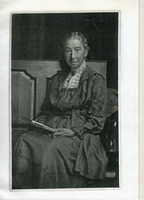 E1a-016b: The Story of the Salts Girls School for Fifty Years: Reminiscences of Harriet Byles, Headmistress 1886-1920 Harriet Byles's reminiscences of working at the Salt High School for Girls from the 1870s until retitement in 1920. Byles started as a teacher when the first headmistress was Medina Griffiths. Byles became the second headmistress in 1886 and continued a programme of progressive, wide education for her students.
E1a-016b: The Story of the Salts Girls School for Fifty Years: Reminiscences of Harriet Byles, Headmistress 1886-1920 Harriet Byles's reminiscences of working at the Salt High School for Girls from the 1870s until retitement in 1920. Byles started as a teacher when the first headmistress was Medina Griffiths. Byles became the second headmistress in 1886 and continued a programme of progressive, wide education for her students. -
 E2b-026b: Shipley Technical School viewed from Caroline Street Photograph of Shipley Technical School on Exhibition Road in Saltaire taken from nearby Caroline Street. The image appears in the Technical School prospectus for 1919-1920. The Technical School was originally named the School of Art and Science. It is now part of Shipley College.
E2b-026b: Shipley Technical School viewed from Caroline Street Photograph of Shipley Technical School on Exhibition Road in Saltaire taken from nearby Caroline Street. The image appears in the Technical School prospectus for 1919-1920. The Technical School was originally named the School of Art and Science. It is now part of Shipley College. -
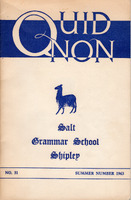 Salt Grammar School The successor school to the Salt High Schools following the education reforms of 1944. It subsequently became the comprehensive Sir Titus Salt school and is now located just outside Saltaire on the north side of Roberts Park.
Salt Grammar School The successor school to the Salt High Schools following the education reforms of 1944. It subsequently became the comprehensive Sir Titus Salt school and is now located just outside Saltaire on the north side of Roberts Park. -
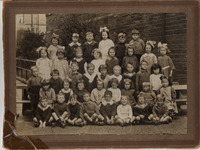 E1b-012a: Albert Road School children 1 original print of Albert Road School children (1920) 'Dad's School' ( 'Dad' is marked with a pen)
E1b-012a: Albert Road School children 1 original print of Albert Road School children (1920) 'Dad's School' ( 'Dad' is marked with a pen) -
 E1b-115: Drawing of Salts High School 1874 A collection of photographs of Salts High School building: Laminated copy of a drawing of Salts High School (1874)
E1b-115: Drawing of Salts High School 1874 A collection of photographs of Salts High School building: Laminated copy of a drawing of Salts High School (1874) -
Albert Road School buildings, Saltaire, West Yorkshire, United KingdomAs the population of Saltaire grew, the Factory School on Victoria Road (today the Salt Building) became inadequate for the number of children requiring an education. The Salt family provided land on the Western side of Albert Road for the building of a new school for primary education.The local school board opened the Albert Road Board Schools in 1878 to cater for 815 younger children. The original Factory School on Victoria Road remained in use as the High School. The building is still in use and today hosts Saltaire Primary School.
-
E1b-050: Panorama framed school photographs - Salts School for Boys - July 1927Panorama framed school photographs - Salts School for Boys - July 1927
-
E1b-051: Panorama framed school photographs - Salts Boys High School - July 1932Panorama framed school photographs - Salts Boys High School - July 1932
-
E1b-054: Panorama framed school photographs - The Salt High School - October 1956Panorama framed school photographs - The Salt High School - October 1956
-
E1b-055: Panorama framed school photographs - The Salt Grammar School - April 1960Panorama framed school photographs - The Salt Grammar School - April 1960
-
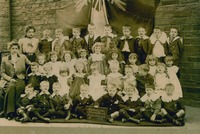 Albert Road School A new primary school on Albert Road in Saltaire was opened in 1878, its creation supported by husband and wife Titus Salt Junior and Catherine Salt. It has remained a primary school until the present day. When it opened, Children at the Albert Road schools were taught in mixed classes of around 40 children, although boys and girls were still seated in separate halves of the room, and corporal punishment was forbidden. At the time, the Shipley and Saltaire Times reported that people were doubtful whether this new approach to education would work. Shortly after their opening, the same newspaper printed a report on the schools and retracted their earlier criticism.
Albert Road School A new primary school on Albert Road in Saltaire was opened in 1878, its creation supported by husband and wife Titus Salt Junior and Catherine Salt. It has remained a primary school until the present day. When it opened, Children at the Albert Road schools were taught in mixed classes of around 40 children, although boys and girls were still seated in separate halves of the room, and corporal punishment was forbidden. At the time, the Shipley and Saltaire Times reported that people were doubtful whether this new approach to education would work. Shortly after their opening, the same newspaper printed a report on the schools and retracted their earlier criticism. -
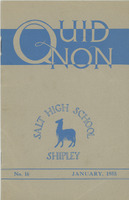 2018.65: Salt High School Magazine The 16th issue of the Salt High School magazine from January 1955, featuring news about school sports, societies and field trips.
2018.65: Salt High School Magazine The 16th issue of the Salt High School magazine from January 1955, featuring news about school sports, societies and field trips. -
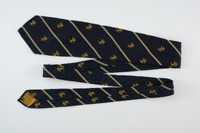 E1a-085: School tie A Salt High School tie. Dark blue in colour with a repeated golden logo of an lion.
E1a-085: School tie A Salt High School tie. Dark blue in colour with a repeated golden logo of an lion. -
 E1a-084: School tie A Salt High School tie. Dark blue in colour with a repeated golden logo of an alpaca.
E1a-084: School tie A Salt High School tie. Dark blue in colour with a repeated golden logo of an alpaca.
Catalogue data (excluding media) available under Creative Commons Attribution-ShareAlike (CC BY-SA 4.0) licence.